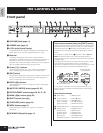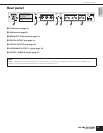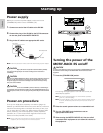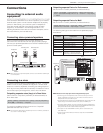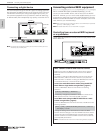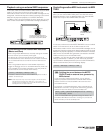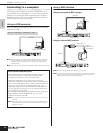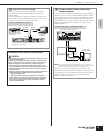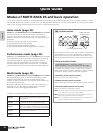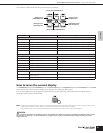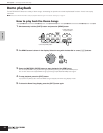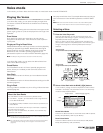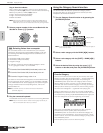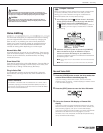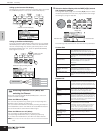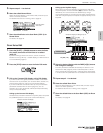
Owner’s Manual
20
Quick Guide
Modes of MOTIF-RACK ES and basic operation
In this section, we’ll take a look at the fundamental operating conventions of the MOTIF-RACK ES. Here, you’ll learn the basics – how to
select modes and call up the various functions. You can play the MOTIF-RACK ES in the three modes below. You can select the desired
mode, to suit your particular playing style, music genre or production environment.
Voice mode (page 23)
The Voice mode lets you play a wide range of dynamic and
authentic instrument sounds (Voices). Only one Voice can be
played simultaneously. Use this mode when you want to play just a
single Part.
There are three types of Voices as shown below.
• Normal Voices (instrument sounds)
• Drum Voices (percussion/drum sounds)
• Plug-in Board Voices (with Single-part Plug-in Board)
Performance mode (page 30)
The Performance mode lets you play a Performance by layering
several Voices together, and by assigning different Voices to
separate ranges of the keyboard. You can create rich, layered
sounds or play two different Parts simultaneously – for example,
piano and bass guitar. This mode is useful when performing solo.
Multi mode (page 36)
The Multi Mode lets you set up the MOTIF-RACK ES as a multi-
timbral tone generator for use with computer-based music
software or external sequencers. You can play various Voices (up
to 33 Parts) simultaneously.
By assigning different Voices to each track in a song file of your
sequencer, you can play back a complex band or ensemble
performance with just a single MOTIF-RACK ES.
In addition, the MOTIF-RACK ES provides the following functions.
Quick Guide
Arpeggio
(page 42)
This function lets you trigger rhythm patterns, riffs and
phrases using the current Voice by simply playing notes
on the keyboard.
Control Set
(page 45)
This function lets you control the various functions of the
MOTIF-RACK ES with an external MIDI controller.
Job
(page 47)
This function lets you reset the MOTIF-RACK ES to the
initial factory settings (Factory Set), copy data, initialize
data, and save data to an external device (Bulk Dump).
Store
(page 49)
This lets you save the edited Voices and various
settings to the MOTIF-RACK ES.
Utility
(page 89)
This lets you set the overall system of the MOTIF-RACK
ES.
Audition function
This convenient function lets you hear an Audition phrase playing
the selected Voice. To use this, simultaneously hold down the
[SHIFT] button and press the [AUDITION] button. Make sure to
keep holding down both buttons to continue playing the phrase.
Editing an Audition Phrase
[VOICE]/[SHIFT]+[DRUM] → select Voice → [EDIT] →
[SHIFT]+[COMMON] → select General display with PAGE [E][F]
The phrase type and pitch can be changed in the Voice Edit
mode. There are two parameters related to the audition phrase in
the “General” display in Voice Common Edit (page 65).
A.PhraseNo. (Audition phrase number)
Selects the type of the Audition phrase.
A.PhrNtSft (Audition phrase note shift)
Determines the pitch settings of the Audition phrase in semitones.
A.PhrVelSft (Audition phrase velocity shift)
Selects the velocity of the Audition phrase.
n The Audition phrase can be transmitted via MIDI. The transmit channel of
the Audition phrase can be also changed (page 90).
n Depending on the Audition phrase, the sound character may also be
adjusted by using MIDI Control Change messages.
n When an Arpeggio is used as the Audition phrase, the playback sound
may differ between the Voice and Multi modes.
TIP
1) While holding down
the [SHIFT] button…
2) Press the [AUDITION] button.



